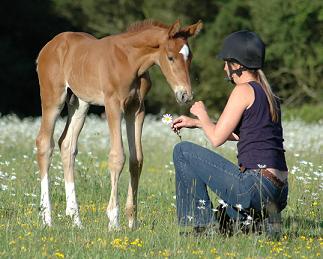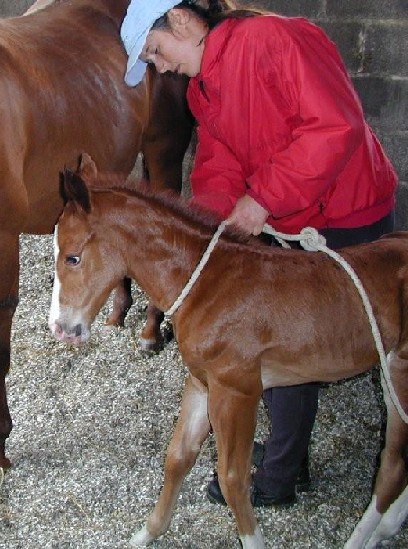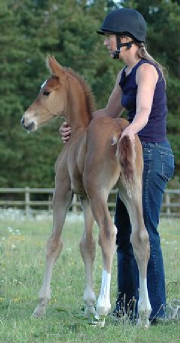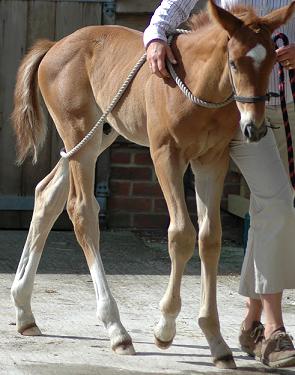
|
| Sometimes all you need is patience and a flower to make a new friend |
Foal Handling
Being
able to handle a foal from the moment it is born, or as soon as possible, can often save time and trauma later in the horse’s
life.
‘Imprinting’ if done correctly can instil life-long confidence in the young foal
,desensitising them to movement, sounds and feel of many things perceived as potential threats as a prey animal.
This could be plastic bags, water spray bottles(prep for fly spray), clippers, stones shaken in a plastic bottle, bath towel
rubbed all over, umbrellas, the popping sound of a champagne cork (“Yes it’s a colt with 4 white socks and a blaze!”)
and of course being touched all over with the human (predator) hand.

During this early handling, it is vital that the bond between the mare and foal is not compromised and
also extremely important not to ‘over-do’ the imprinting- certain parts of his body still need to be sensitive
such as where our legs will hang on him one day and of course, the sensitive tissues of the mouth.
Some
mares are very foal proud so unless there is a competent person to keep the mare quiet it can be too risky to proceed with
working on the foal. Also if the newborn foal is allowed to struggle and get up too soon due to improper handling, then
the mare will get stressed and not let her milk down which contains the vital nutrients and antibodies in the colostrum.
Although we would like our ‘domestic’
foal not to fear us, we aim to build a healthy respect too by teaching him to yield willingly to the slightest pressure
of our hands or lead ropes, otherwise we end up with a foal who doesn’t stay out of our personal space. Orphan
foals can become aggressive and dominant very easily as we give them lots of love and endless feed but not usually enough
leadership or boundaries - like spoilt children.
Ideally within a few sessions the foal should be able to be caught and haltered in a small enclosure/stable, touched all
over, all 4 feet picked up, be able to move his head downwards with gentle poll pressure, be able to move its neck laterally,
move his hindquarters and forequarters over, stand still and move backwards willingly and softly. Once this is accomplished
I would move on to teach the foal to lead.

As the foal grows older he will feel more confident being led further away from his mother which will help
prepare him for loading in a trailer/lorry for shows/vets or change of location at weaning time. Some foals are ready
to learn to tie up when they are around 3 months old but they have to be so confident with yielding to pressure, lead willingly
and not be worried about ropes falling around their legs should they accidently untie themselves.
Knowing how to read horse behaviour, having accurate feel ,timing and attitude whilst preserving
the animal’s dignity, is essential to working with any age horse but even more so during the short ‘window of
opportunity’ in the first few days of life. Time spent now will pay dividends later. Although I enjoy watching
a foal learn all these ‘domestic’ skills, I also love to watch them being a horse!
It is important they live as natural a life as possible playing with others of the same age and ideally being
part of a herd with uncles and aunties disciplining them when necessary. We can learn so much just by watching how the
herd acts and interacts, it’s not always the aggressive horse that rules the herd, more likely a passive leader.
They are calm but confident, only being assertive not aggressive when re-establishing themselves as the herd leader when needed,
which is how we should act when around our horses.
